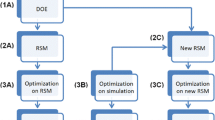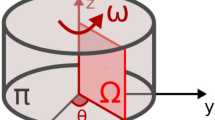Abstract
Flow machines are very important to industry, being widely used on various processes. Performance improvements are relevant factors and can be achieved by using optimization methods, such as topology optimization. Thus, this work aims to perform the complete development cycle of a small scale pump designed by using topology optimization method. For the pump modelling the finite element method is applied to solve the Navier-Stokes equations on a rotating reference frame. In the optimization phase, it is defined a multi-objective function that aims to minimize the viscous energy dissipation and vorticity. The optimized results obtained by using topology optimization are post-processed and manufactured by using a 3D printer, and prototypes with an electric motor are built. An experimental characterization is performed by measuring fluid flow and pressure head given by the pumps. Experimental and computational results are compared and the improvement is verified.



















Similar content being viewed by others
References
Aaronson KD, Slaughter MS, Miller LW, McGee EC, Cotts WG, Acker MA, Jessup ML, Gregoric ID, Loyalka P, Frazier OH, Jeevanandam V, Anderson AS, Kormos RL, Teuteberg JJ, Levy WC, Naftel DC, Bittman RM, Pagani FD, Hathaway DR, Boyce SW (2012) Use of an intrapericardial, continuous-flow, centrifugal pump in patients awaiting heart transplantation. Circulation 125 (25):3191–3200
Abraham F, Behr M, Heinkenschloss M (2004) The effect of stabilization in finite element methods for the optimal boundary control of the Oseen equations. Finite Elem Anal Des 41(3):229–251
Amestoy PR, Duff IS, L’Excellent J-Y, Koster J (2001) A fully asynchronous multifrontal solver using distributed dynamic scheduling. SIAM J Matrix Anal Appl 23(1):15–41
Amigo R, Giusti SM, Novotny AA, Silva ECN, Sokołowski J (2016) Optimum design of flextensional piezoelectric actuators into two spatial dimensions. SIAM J Control Optim 54(2):760–789
Baloni BD, Pathak Y, Channiwala S (2015) Centrifugal blower volute optimization based on Taguchi method. Comput Fluids 112:72–78
Barenboim AB, Vasil’tsov A (1965) Effect of the Reynolds number on the pump characteristics. Chem Pet Eng 1(2):118–122
Berggren M (1998) Numerical solution of a flow-control problem: vorticity reduction by dynamic boundary action. SIAM J Sci Comput 19(3):829–860
Borrvall T, Petersson J (2003) Topology optimization of fluids in Stokes flow. Int J Numer Methods Fluids 41(1):77–107
Casas V, Pena F, Duro R (2006) Automatic design and optimization of wind turbine blades. In: 2006 International conference on computational inteligence for modelling control and automation and international conference on intelligent agents web technologies and international commerce (CIMCA’06). IEEE, pp 205–205
Day SW, Lemire PP, Flack RD, McDaniel JC (2003) Effect of Reynolds number on performance of a small centrifugal pump. In: Volume 1: Fora, Parts A, B, C, and D. ASME, pp 1893–1899
Deng Y, Liu Z, Wu J, Wu Y (2013) Topology optimization of steady Navier–Stokes flow with body force. Comput Methods Appl Mech Eng 255:306–321
Derakhshan S, Pourmahdavi M, Abdolahnejad E, Reihani A, Ojaghi A (2013) Numerical shape optimization of a centrifugal pump impeller using artificial bee colony algorithm. Comput Fluids 81:145–151
Evgrafov A (2004) Topology optimization of slightly compressible fluids. Doktorsavhandlingar vid Chalmers Tekniska Hogskola 62(1):55–81
Evgrafov A (2005) The limits of porous materials in the topology optimization of stokes flows. Appl Math Optim 52(3):263–277
Fraser WH (1981) Flow recirculation in centrifugal pumps. In: Proceedings of the tenth turbomachinery symposium, pp 95–100
Funke SW, Farrell PE (2013) A framework for automated PDE-constrained optimisation. arXiv:1302.3894
Gȯlcu̇ M, Pancar Y, Sekmen Y (2006) Energy saving in a deep well pump with splitter blade. Energy Convers Manag 47(5):638–651
Lee Y-T, Ahuja V, Hosangadi A, Slipper ME, Mulvihill LP, Birkbeck R, Coleman RM (2011) Impeller design of a centrifugal fan with blade optimization. Int J Rotat Mach 2011:1–16
Logg A, Wells GN, Book TF (2012) Automated solution of differential equations by the finite element method, volume 84 of lecture notes in computational science and engineering. Springer, Berlin
Nishiwaki S, Frecker MI, Min S, Kikuchi N (1998) Topology optimization of compliant mechanisms using the homogenization method. Int J Numer Methods Eng 42(3):535–559
Olesen LH, Okkels F, Bruus H (2006) A high-level programming-language implementation of topology optimization applied to steady-state navier–stokes flow. Int J Numer Methods Eng 65(7):975–1001
Quarteroni A, Rozza G (2003) Optimal control and shape optimization of aorto-coronaric bypass anastomoses. Math Models Methods Appl Sci 13(12):1801–1823
Romero JS, Silva ECN (2014) A topology optimization approach applied to laminar flow machine rotor design. Comput Methods Appl Mech Engrg 279:268–300
Sá LFN, Novotny AA, Romero JS, Silva ECN (2017) Design optimization of laminar flow machine rotors based on the topological derivative concept. Struct Multidiscip Optim 56:1013
Sigmund O (1997) On the design of compliant mechanisms using topology optimization*. Mech Struct Mach 25(4):493–524
Wächter A (2009) Short tutorial: getting started with Ipopt in 90 minutes. In: Toledo UN, Schenk O, Simon HD, Sivan (eds) Combinatorial scientific computing, Dagstuhl, Germany. Schloss Dagstuhl - Leibniz-Zentrum fuer Informatik, Germany
Wȧchter A, Biegler LT (2006) On the implementation of an interior-point filter line-search algorithm for large-scale nonlinear programming. Math Program 106(1):25–57
Wen-Guang L (2011) Inverse design of impeller blade of centrifugal pump with a singularity method. Jordan J Mech Indus 5(2):119–128
Yu S, Ng B, Chan W, Chua L (2000) The flow patterns within the impeller passages of a centrifugal blood pump model. Med Eng Phys 22(6):381–393
Zhu B, Zhang X, Fatikow S (2014) A multi-objective method of hinge-free compliant mechanism optimization. Struct Multidiscip Optim 49(3):431–440
Zhu B, Zhang X, Fatikow S (2015) Structural topology and shape optimization using a level set method with distance-suppression scheme. Comput Methods Appl Mech Eng 283(Supplement C):1214–1239
Acknowledgements
This research was partly supported by CNPq (Brazilian Research Council) and FAPESP (Sao Paulo Research Foundation). The authors thank the supporting institutions. The first author thanks the financial support of FAPESP under grants 2016/19261-7, 2013/24434-0, and 2014/50279-4. The fourth author thanks the financial support of CNPq (National Council for Research and Development) under grant 304121/2013-4. Authors thank the NDF laboratory at Mechanical Engineering Department for sharing the ANSYS license.
Author information
Authors and Affiliations
Corresponding author
Additional information
Responsible Editor: Anton Evgrafov
Publisher’s Note
Springer Nature remains neutral with regard to jurisdictional claims in published maps and institutional affiliations.
Appendix A: Mesh convergence analysis
Appendix A: Mesh convergence analysis
A mesh convergence analysis is performed for each rotor presented in Section 7.2.1. All meshes have a inflation refinement at the wall considering the first layer with 0.1[mm] and 10 layers with 5% growth rate. The convergence analysis is performed by changing the max element size and evaluating the desired variable. In pumps, usually, the convergence analysis is performed by considering the pressure convergence, however, in this case we are interested in the energy dissipation and vorticity. Thus these variables are also considered. The convergence analysis for all cases is done by considering the operation point of 2500[rpm] and the highest mass flow, i.e., 3.67[l/min] for the straight blade, 3.3[l/min] for the rotor optimized for energy dissipation and 3.61[l/min] for the rotor optimized for energy dissipation and vorticity.
The convergence analysis is performed for each variable. The pressure values are shown in Fig. 20. As we can see the convergence occurs even with a low number of elements in the pressure variable. However, the final mesh needs to be converged for the interest variable.
Figure 21 shows the energy dissipation variation with the number of elements for each rotor. The last mesh analyzed has around 12,5 million of elements and the convergence is still not achieved. This is the limit of our computer power and takes a long time to calculate. Despite this, the overall tendency is that the optimized rotors present lower values of energy dissipation.
Figure 22 shows the vorticity variation with the number of elements for each model. Again, the expected convergence is not achieved with our computer power, nevertheless the conclusion of the straight blade rotor having a worse vorticity value still is preserved, even for low discretization meshes.
Thus, the results presented in Section 7.2.1 are obtained with an intermediary mesh consisting of around 5.5 million of elements and the conclusions are expected to be valid even for a mesh with higher discretization.
Rights and permissions
About this article
Cite this article
Sá, L.F.N., Romero, J.S., Horikawa, O. et al. Topology optimization applied to the development of small scale pump. Struct Multidisc Optim 57, 2045–2059 (2018). https://doi.org/10.1007/s00158-018-1966-7
Received:
Revised:
Accepted:
Published:
Issue Date:
DOI: https://doi.org/10.1007/s00158-018-1966-7







